2016 in Review and Top 20 + 10 Shakespeareances
A Prosperous Year, Despite Being So Rotten
We even had Hoppin' John and collard greens last New Year's Day. Still, 2016 was a bummer—except for theater in general and Shakespeare in particular.
The year started on an up note. My professional standing attained new heights, and Shakespereances.com was attracting record numbers of visitors. However, my father's health was failing, and he passed away in late March. It's been downhill since. Being executor of his estate has required jumping through a ludicrous number of legal and bureaucratic hoops while prolonging my dealing with the grief of loss, not just of my father but resurfacing the loss of my mother eight years ago. My wife, Sarah, began the year seemingly past her medical adventures of 2015, but a new concern surfaced last spring, requiring some major lifestyle changes. With all that hounding my hours, I fell further and further behind keeping up with Shakespeareances.com, and the site's readership declined.
Meanwhile, the world took a bad turn, too, slipping backward to long-past dark ages. Elections around the globe seemed to be a zombie-like call on xenophobia, racism, name-calling hatred, and bullying, raising attitudes that should have been killed off by obvious evidence and eating the brains of seemingly sensible people. As the fake world of reality TV has become our real world upon the dawn of 2017, I'm not sure Hoppin' John and collard greens stand a chance.
At least we have theater. It keeps us entertained, and it keeps us honest in the way of self-reflection (if we'd only look). In 2016, theater did both exceptionally well. We attended 64 productions this year, 34 of them with scripts written by William Shakespeare, eight adaptations of his plays, and one about Shakespeare (as a measure of my own level of production with Shakespeareances.com this year, I have yet to write reviews for 21 of these shows).
It was the year of Verona: we saw six productions of Romeo and Juliet and two of Two Gentlemen of Verona. Romeo and Juliet was an apt choice for directors looking to reflect on the rising tide of violence in our communities. Shakespeare, though, proved his relevance to 2016 with many of his plays, even without heavy adaptation or cuts. His history plays became chronicles of our own times, Richard III becoming a particularly menacing parable. Othello, The Merchant of Venice, Measure for Measure, and Coriolanus became frighteningly self-reflective. Meanwhile, a new adaptation of 1984 revealed that George Orwell was more accurately prophetic than we had realized (or wanted to believe).
For pure entertainment, we saw big-hit wonders from both Bedlam and Fiasco, two New York-based theater companies featuring young actors and innovative directors who stretch the boundaries of what constitutes theatrical experience. Meanwhile, one of our favorite playhouses, the Blackfriars, attained new heights in consistent excellence across three different companies of actors over the calendar year. Our own theater calendar started in January with a fun take on murder, mayhem, and death in Shakespeare. It ended this month with a spiritually uplifting medieval mystery play. Throughout the year our ongoing theatrical experiences helped us cope with something of a rotten year.
One Rotten play in particular. This was the year in which Something Rotten!, the Broadway musical at the St. James Theatre in New York, could have topped both my Top 20 Shakespeareances and the Top 10 Honorable Mentions (non-Shakespeare productions). This send-up of Bardolatry and Broadway musicals (a send-up that ultimately exonerates both Bardolatry and musicals) is so much fun and so rich in Shakespearean textures (not to mention so many great puns) that it came to dominate our theater landscape this year. We play the original cast album so often that I have all the lyrics memorized with proper inflection (“No talking?” “No tal-Kiiiiing: And they often stay on one note for a very long time so that when they change to a different note you notiiiiiice”). We constantly reference the show in our conversations (“It's so incredibly hard to be the bard! Honestly, I don't know how I do it”). Christian Borle's portrayal of the rock god Shakespeare got in my system like no performance I've experienced since Anthony Hopkins in Pravda in 1985: I find myself often slipping into the mannerisms and expressions of Borle's Will (though I don't wear a bulging codpiece). We saw this show in March; but that was our second time. We saw it last November, and it landed at Number Two on the 2015 non-Shakespeare list (a year in which Faction of Fool's epiphanic production of Our Town lapped all other theater experiences). This year, while Something Rotten! was our brightest theater highlight, I decided to use a Tony qualification standard, listing only productions we see initially in the year (though that includes restagings).
That's fair because, frankly, we saw so much great theater this year (only three clunkers with no redeeming value) that ranking them proved more difficult than usual. In fact, not one, but two productions top the Shakespeareances list, thanks to a singular character who, in many ways, is the most self-reflective Shakespeareances for me (and perhaps should be for all of us) as we pass from 2016 into a new beginning.
Top 20 Shakespeareances of 2016
- Prospero (René Thornton Jr. at the American Shakespeare Center and Patrick Page at the Shakespeare Theatre Company).
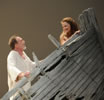
 The sometime Duke of Milan at the center of The Tempest has been one of my favorite characters in the canon since the first time I read the play 40 years ago. However, while I've seen many fine performances, I've never seen any totally satisfying ones. This year, I saw two perfect Prosperos, yet both different. René Thornton Jr. in the ASC production delved into Prospero's psychosis, revealing there a man haunted by his past, present, and future while dedicated to his duties as a father, none of which he can fully control despite his former political power and current magical powers. It was a resonating portrayal of depression. Patrick Page, taking on the role in a remounting of STC's 2014 production, focused on Prospero the father—not just to Miranda, the centerpiece of his life, but to Ariel and even Caliban. With impeccable stagecraft, Page dug up so many treasures in the text that we seemed to be seeing the play for the first time rather than the 15th (and this particular production for the second time). My rule has always been that I should pick one over the other, but this time I can't. So, I fall back on the character itself as Shakespeare wrote him and these two actors in top form played him with uncorrupted portrayals: simply, Prospero, a man who, like all of us, is limited by his circumstances and his humanness despite his considerable powers.
The sometime Duke of Milan at the center of The Tempest has been one of my favorite characters in the canon since the first time I read the play 40 years ago. However, while I've seen many fine performances, I've never seen any totally satisfying ones. This year, I saw two perfect Prosperos, yet both different. René Thornton Jr. in the ASC production delved into Prospero's psychosis, revealing there a man haunted by his past, present, and future while dedicated to his duties as a father, none of which he can fully control despite his former political power and current magical powers. It was a resonating portrayal of depression. Patrick Page, taking on the role in a remounting of STC's 2014 production, focused on Prospero the father—not just to Miranda, the centerpiece of his life, but to Ariel and even Caliban. With impeccable stagecraft, Page dug up so many treasures in the text that we seemed to be seeing the play for the first time rather than the 15th (and this particular production for the second time). My rule has always been that I should pick one over the other, but this time I can't. So, I fall back on the character itself as Shakespeare wrote him and these two actors in top form played him with uncorrupted portrayals: simply, Prospero, a man who, like all of us, is limited by his circumstances and his humanness despite his considerable powers.
- Twelfth Night, American Shakespeare Center, Blackfriars Playhouse, Staunton, Virginia. Fabian himself calls Twelfth Night
 an "improbable fiction," and so many directors over time have tried to make the play less improbable, losing sight of how perfectly Shakespeare crafted this masterpiece. Beth Burns, however, let the play be itself. She also kept the harness off her verse-adept American Shakespeare Center cast and the Blackfriars Playhouse itself, bringing forth the play's chief point: when it comes to matters of the heart, there is only improbable fact. René Thornton Jr. was so superb as Malvolio he left his fellow players in awe, and Allison Glenzer was astonishing as Olivia. Chris Johnston channeled Woodie Guthrie in his portrayal of Feste, and Blackfriars newcomer Jessika Williams found depths in the details of her Viola, matched by Benjamin Reed's Sebastian.
an "improbable fiction," and so many directors over time have tried to make the play less improbable, losing sight of how perfectly Shakespeare crafted this masterpiece. Beth Burns, however, let the play be itself. She also kept the harness off her verse-adept American Shakespeare Center cast and the Blackfriars Playhouse itself, bringing forth the play's chief point: when it comes to matters of the heart, there is only improbable fact. René Thornton Jr. was so superb as Malvolio he left his fellow players in awe, and Allison Glenzer was astonishing as Olivia. Chris Johnston channeled Woodie Guthrie in his portrayal of Feste, and Blackfriars newcomer Jessika Williams found depths in the details of her Viola, matched by Benjamin Reed's Sebastian.
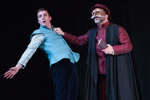 The Merchant of Venice, Faction of Fools, Washington, D.C. I counted on a commedia dell'arte version of The Merchant of Venice to deliver an unabashedly pure take on Shakespeare's most controversial comedy and an honest approach to Shylock. Faction of Fool's commedia staging, however, was so much more than that. Under Paul Reisman's insightful direction, this play's direct links to the commedia form emerged, which, in turn, made for a holistically satisfying comic play. Matthew Pauli, using expert verse readings and great subtlety of character, presented one of the most fully fleshed Shylocks I've ever seen, despite playing him in a Pantaloon's mask. Vince Eisenson turned in stunning performances as Bassanio and Tubal, and Natalie Cutcher took Portia down from her pedestal, playing her as a Innamorati at Belmont and an Il Capitano when disguised as a boy, refashioning the "quality of mercy" speech into the farce that might have been intended. Oh, we laughed, at both the intelligent and physical humor of this play. We also were genuinely moved when Pauli's Shylock showed us the answer to his rhetorical question, what is a Jew? A man. It is us who put him in a mask.
The Merchant of Venice, Faction of Fools, Washington, D.C. I counted on a commedia dell'arte version of The Merchant of Venice to deliver an unabashedly pure take on Shakespeare's most controversial comedy and an honest approach to Shylock. Faction of Fool's commedia staging, however, was so much more than that. Under Paul Reisman's insightful direction, this play's direct links to the commedia form emerged, which, in turn, made for a holistically satisfying comic play. Matthew Pauli, using expert verse readings and great subtlety of character, presented one of the most fully fleshed Shylocks I've ever seen, despite playing him in a Pantaloon's mask. Vince Eisenson turned in stunning performances as Bassanio and Tubal, and Natalie Cutcher took Portia down from her pedestal, playing her as a Innamorati at Belmont and an Il Capitano when disguised as a boy, refashioning the "quality of mercy" speech into the farce that might have been intended. Oh, we laughed, at both the intelligent and physical humor of this play. We also were genuinely moved when Pauli's Shylock showed us the answer to his rhetorical question, what is a Jew? A man. It is us who put him in a mask.
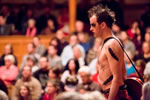 The Tempest, American Shakespeare Center, Blackfriars Playhouse, Staunton, Virginia. "Well crafted" is the adjective I used in my review, an important choice of words as this production was "crafted" by 12 individual actors without a director in less than six days of rehearsal. The talent and intelligence each actor brought to his or her part and the ensemble quality of the action, especially with René Thornton Jr.'s transcendent existentialist Prospero, Lauren Ballard's obviously 15-year-old castaway Miranda, Chad Bradford's bumbling Ferdinand, Chris Johnston's banjo-wielding Ariel, John Harrell's snobbish valet Stephano, Aiden O'Reilly's Joker of a jester Trinculo, Patrick Midgley's sweetly vitriolic Caliban, and Jonathan Holtzman's dedicated-to-despair Alonso. This is a Tempest of definitives.
The Tempest, American Shakespeare Center, Blackfriars Playhouse, Staunton, Virginia. "Well crafted" is the adjective I used in my review, an important choice of words as this production was "crafted" by 12 individual actors without a director in less than six days of rehearsal. The talent and intelligence each actor brought to his or her part and the ensemble quality of the action, especially with René Thornton Jr.'s transcendent existentialist Prospero, Lauren Ballard's obviously 15-year-old castaway Miranda, Chad Bradford's bumbling Ferdinand, Chris Johnston's banjo-wielding Ariel, John Harrell's snobbish valet Stephano, Aiden O'Reilly's Joker of a jester Trinculo, Patrick Midgley's sweetly vitriolic Caliban, and Jonathan Holtzman's dedicated-to-despair Alonso. This is a Tempest of definitives.
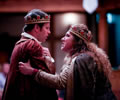 Henry VI, Part Two, American Shakespeare Center, Blackfriars Playhouse, Staunton, Virginia. The primary redeeming value of last year's American Shakespeare Center production of Henry VI, Part One, was knowing that Allison Glenzer would continue as Queen Margaret in Part Two this year. High expectations met. We also looked forward to René Thornton Jr.'s first appearance as the future Richard III in this production. High anticipation surpassed. We also appreciated that Chris Johnston was getting his first bona fide title role in a Shakespeare play. High hopes met. What we didn't expect was how the entire ensemble under the virtuosic direction of Jim Warren would give each character 4-D depth and reveal this to be among Shakespeare's best compositions in both character portrayal and poetic power.
Henry VI, Part Two, American Shakespeare Center, Blackfriars Playhouse, Staunton, Virginia. The primary redeeming value of last year's American Shakespeare Center production of Henry VI, Part One, was knowing that Allison Glenzer would continue as Queen Margaret in Part Two this year. High expectations met. We also looked forward to René Thornton Jr.'s first appearance as the future Richard III in this production. High anticipation surpassed. We also appreciated that Chris Johnston was getting his first bona fide title role in a Shakespeare play. High hopes met. What we didn't expect was how the entire ensemble under the virtuosic direction of Jim Warren would give each character 4-D depth and reveal this to be among Shakespeare's best compositions in both character portrayal and poetic power.
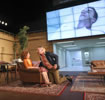 Kings of War, Toneelgroep Amsterdam, BAM New Wave Festival, Brooklyn, New York. This ambitious, 4 1/2-hour reconstitution of Shakespeare's history cycles as a modern documentary of kingship achieved in many different spheres. Merging video with live action extended the theater and cast while providing multiple viewing angles to key moments in the script. The adaption and translation (from Dutch to English) masterfully honed Shakespeare's text into a thematic focus while echoing the original's image-filled poetry. However, it was the acting that ultimately carried this production to the upper Shakespearean echelons, especially that of Hans Kesting as a birthmarked, psychologically scarred Richard. [Not yet reviewed.]
Kings of War, Toneelgroep Amsterdam, BAM New Wave Festival, Brooklyn, New York. This ambitious, 4 1/2-hour reconstitution of Shakespeare's history cycles as a modern documentary of kingship achieved in many different spheres. Merging video with live action extended the theater and cast while providing multiple viewing angles to key moments in the script. The adaption and translation (from Dutch to English) masterfully honed Shakespeare's text into a thematic focus while echoing the original's image-filled poetry. However, it was the acting that ultimately carried this production to the upper Shakespearean echelons, especially that of Hans Kesting as a birthmarked, psychologically scarred Richard. [Not yet reviewed.]
 The Merchant of Venice, Shakespeare's Globe, Kennedy Center, Washington, D.C. Double the Pryce: Jonathan Pryce, mastering Shakespeare's lines so expertly, fully immersed in his playing of Shylock as a man fed up with lifelong discrimination; his daughter, Phoebe Pryce, playing Shylock's daughter, Jessica, intelligently carrying the play's themes to a haunting end. Director Jonathan Munby's studied staging set the play in Renaissance Venice while its thematic resonance played out disturbingly on our modern landscape. Yet we laughed, for good at Stefan Adegbola's improv riffs as Launcelot, and for bad at Jolyon Coy's virulent racist Gratiano.
The Merchant of Venice, Shakespeare's Globe, Kennedy Center, Washington, D.C. Double the Pryce: Jonathan Pryce, mastering Shakespeare's lines so expertly, fully immersed in his playing of Shylock as a man fed up with lifelong discrimination; his daughter, Phoebe Pryce, playing Shylock's daughter, Jessica, intelligently carrying the play's themes to a haunting end. Director Jonathan Munby's studied staging set the play in Renaissance Venice while its thematic resonance played out disturbingly on our modern landscape. Yet we laughed, for good at Stefan Adegbola's improv riffs as Launcelot, and for bad at Jolyon Coy's virulent racist Gratiano.
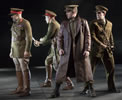 Othello, Shakespeare Theatre Company, Washington, D.C. In this bare-bones production, Director Ron Daniels delivered one of the more relevant readings of Othello I've ever experienced. Start with casting Faran Tahir, a Pakastini-American, in the title role, playing the Moor as the Muslim that Shakespeare intended. Iago, meantime, was among the scariest I've encountered because he sounded like so many people I know, living by a "tell it like it is" philosophy that is anything but truth. Though set 100 years ago, this Othello's military foundation and racist bearings made it seem so 2016.
Othello, Shakespeare Theatre Company, Washington, D.C. In this bare-bones production, Director Ron Daniels delivered one of the more relevant readings of Othello I've ever experienced. Start with casting Faran Tahir, a Pakastini-American, in the title role, playing the Moor as the Muslim that Shakespeare intended. Iago, meantime, was among the scariest I've encountered because he sounded like so many people I know, living by a "tell it like it is" philosophy that is anything but truth. Though set 100 years ago, this Othello's military foundation and racist bearings made it seem so 2016.
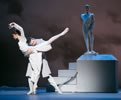 The Winter's Tale, National Ballet of Canada, Kennedy Center, Washington, D.C. When the Bohemian scenes washed over me—Christopher Wheeldon's crisply metaphorical choreography, luminous and athletic performances by the entire corps of dancers, Joby Talbot's soaring music, and Bob Crowley's vividly exotic set and costumes—I realized how perfectly Shakespeare adapted his play for the purposes of ballet. With a few notable exceptions, this piece stays true to the text, and some of the departures are just so right, like the emphasis on Paulina's dual tragedies. Wheeldon and Talbot have created a ballet classic and a Shakespearean masterpiece.
The Winter's Tale, National Ballet of Canada, Kennedy Center, Washington, D.C. When the Bohemian scenes washed over me—Christopher Wheeldon's crisply metaphorical choreography, luminous and athletic performances by the entire corps of dancers, Joby Talbot's soaring music, and Bob Crowley's vividly exotic set and costumes—I realized how perfectly Shakespeare adapted his play for the purposes of ballet. With a few notable exceptions, this piece stays true to the text, and some of the departures are just so right, like the emphasis on Paulina's dual tragedies. Wheeldon and Talbot have created a ballet classic and a Shakespearean masterpiece.
- Measure for Measure, American Shakespeare Center, Blackfriars Playhouse, Staunton, Virginia. This Actors' Renaissance Season production, in which the actors mount the play in abbreviated rehearsal time without a director, perforce brought individual character perspectives to the staging. That made for a fascinating look at Shakespeare's portrayal of Vienna's multiple social segments. It also inspired sterling individual performances. Jonathan Holtzman and Allison Glenzer gave an arresting rendition of Angelo's misguided proposition of Isabella, Patrick Midgley was a charmingly sophisticated Pompey, and Chris Johnston did a star turn as Lucio.
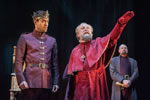 King and Country: Shakespeare's Great Cycle of Kings, Royal Shakespeare Company, BAM, Brooklyn, New York. Although this entailed four distinct productions (Richard II, Henry IV, Parts I and II, and Henry V), I'm combining them here, for not only did they play as one overall presentation under Gregory Doran's direction, we'd already seen the first three plays via “Live from Stratford-upon-Avon” cinema broadcasts (David Tenant as Richard II was Number Two on this list for 2013). Except for Jasper Britton extending his original portrayal of Henry IV to play Bolingbroke in Richard II (replacing Nigel Lindsay in the original production), the first three productions weren't new experiences for us. Henry V was, and it proved a perfect cap to the series, not only with performances led by Alex Hassell as Henry but also in revealing how much comedy is embedded in the play. [Henry V not yet reviewed.]
King and Country: Shakespeare's Great Cycle of Kings, Royal Shakespeare Company, BAM, Brooklyn, New York. Although this entailed four distinct productions (Richard II, Henry IV, Parts I and II, and Henry V), I'm combining them here, for not only did they play as one overall presentation under Gregory Doran's direction, we'd already seen the first three plays via “Live from Stratford-upon-Avon” cinema broadcasts (David Tenant as Richard II was Number Two on this list for 2013). Except for Jasper Britton extending his original portrayal of Henry IV to play Bolingbroke in Richard II (replacing Nigel Lindsay in the original production), the first three productions weren't new experiences for us. Henry V was, and it proved a perfect cap to the series, not only with performances led by Alex Hassell as Henry but also in revealing how much comedy is embedded in the play. [Henry V not yet reviewed.]
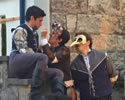 Vince Eisenson as Mercutio in Romeo and Juliet, Patapsco Female Institute Historic Park, Chesapeake Shakespeare Company, Ellicott City, Maryland. In a perfectly adequate, roaming presentation of Romeo and Juliet, we happened upon a definitive portrayal of one of Shakespeare's most fascinating characters. Vince Eisenson's vulgar, vainglorious Mercutio, more drunk than manic, more privileged than immature, was a comprehensively searing piece of work. Eisenson executed the Queen Mab speech with exquisite accuracy, then gave a mesmerizing delivery of the forceful poetry with which he tells Romeo that dreams are nothing. If this be nothing, let me have excess of it.
Vince Eisenson as Mercutio in Romeo and Juliet, Patapsco Female Institute Historic Park, Chesapeake Shakespeare Company, Ellicott City, Maryland. In a perfectly adequate, roaming presentation of Romeo and Juliet, we happened upon a definitive portrayal of one of Shakespeare's most fascinating characters. Vince Eisenson's vulgar, vainglorious Mercutio, more drunk than manic, more privileged than immature, was a comprehensively searing piece of work. Eisenson executed the Queen Mab speech with exquisite accuracy, then gave a mesmerizing delivery of the forceful poetry with which he tells Romeo that dreams are nothing. If this be nothing, let me have excess of it.
 Romeo and Juliet, American Shakespeare Center, Blackfriars Playhouse, Staunton, Virginia. One of my favorite Shakespearean actors over the years, Benjamin Curns (Number One on the Top Shakespeareances list), is becoming one of my favorite Shakespearean directors. However many times I've seen a play (this was my 27th Romeo and Juliet), with Curns at the helm it always seems I'm watching it for the first time, despite his strict fealty to the texts. Or, rather, because of that fealty: he makes key discoveries (Capulet invited Mercutio to the party, so, yeah, they like him a lot) and gleans revealing psychological insights (Friar Laurence's botanical musings lays out the social philosophy that guides his subsequent behavior) that enrich every performance.
Romeo and Juliet, American Shakespeare Center, Blackfriars Playhouse, Staunton, Virginia. One of my favorite Shakespearean actors over the years, Benjamin Curns (Number One on the Top Shakespeareances list), is becoming one of my favorite Shakespearean directors. However many times I've seen a play (this was my 27th Romeo and Juliet), with Curns at the helm it always seems I'm watching it for the first time, despite his strict fealty to the texts. Or, rather, because of that fealty: he makes key discoveries (Capulet invited Mercutio to the party, so, yeah, they like him a lot) and gleans revealing psychological insights (Friar Laurence's botanical musings lays out the social philosophy that guides his subsequent behavior) that enrich every performance.
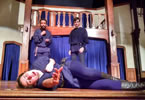 The Complete Deaths of William Shakespeare, Baltimore Shakespeare Factory and Cohesion Theatre Company, St. Mary's Community Center, Baltimore, Maryland. Getting cheeky with the celebratory air surrounding the 400th Anniversary Year of William Shakespeare's death, these two Baltimore theater companies put together a program featuring nothing but the demise of 73 Shakespeare characters plus one fly. With a sense of irreverent fun and utmost respect for Shakespeare, this production was really a celebration of stage combat as the companies' fight choreographers had free reign to stage everything from sword fights and light saber combat to pencil duels and Battleship™.
The Complete Deaths of William Shakespeare, Baltimore Shakespeare Factory and Cohesion Theatre Company, St. Mary's Community Center, Baltimore, Maryland. Getting cheeky with the celebratory air surrounding the 400th Anniversary Year of William Shakespeare's death, these two Baltimore theater companies put together a program featuring nothing but the demise of 73 Shakespeare characters plus one fly. With a sense of irreverent fun and utmost respect for Shakespeare, this production was really a celebration of stage combat as the companies' fight choreographers had free reign to stage everything from sword fights and light saber combat to pencil duels and Battleship™.
-sm.jpg) Antony and Cleopatra, Brave Spirits, Alexandria, Virginia. Director Charlene V. Smith presented this play as epic intimacy in her textually respectful but imaginative production. Joe Carlson and Jessica Lefkow in the title roles were each in their physical and mental portrayals completely besotted with each other, anchoring this production as a mighty love story and anchoring a generally accomplished cast. But the highlight ultimately was Smith's imagination. Cleopatra's throne at the end comprising her fellow actors with Carlson as the seatback and the asp was the most powerful single image I saw on stage this year.
Antony and Cleopatra, Brave Spirits, Alexandria, Virginia. Director Charlene V. Smith presented this play as epic intimacy in her textually respectful but imaginative production. Joe Carlson and Jessica Lefkow in the title roles were each in their physical and mental portrayals completely besotted with each other, anchoring this production as a mighty love story and anchoring a generally accomplished cast. But the highlight ultimately was Smith's imagination. Cleopatra's throne at the end comprising her fellow actors with Carlson as the seatback and the asp was the most powerful single image I saw on stage this year.
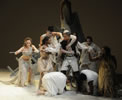 The Tempest, Shakespeare Theatre Company, Washington, D.C. While Patrick Page's Prospero enters this list at number one, the whole production merits a high grade, though this is a restaging of a production we saw in its initial run two years ago. Improvements come with new cast members—Sara Topham as Ariel and Edward Gero as Alonso—and improved performances from Rachel Mewbron as Miranda, Avery Glymph as Ferdinand, and Clifton Duncan as Caliban. Ethan McSweeny could be marked down for some questionable, manipulative cuts of the text, but his deft, character-driven staging is overwhelmingly satisfying.
The Tempest, Shakespeare Theatre Company, Washington, D.C. While Patrick Page's Prospero enters this list at number one, the whole production merits a high grade, though this is a restaging of a production we saw in its initial run two years ago. Improvements come with new cast members—Sara Topham as Ariel and Edward Gero as Alonso—and improved performances from Rachel Mewbron as Miranda, Avery Glymph as Ferdinand, and Clifton Duncan as Caliban. Ethan McSweeny could be marked down for some questionable, manipulative cuts of the text, but his deft, character-driven staging is overwhelmingly satisfying.
- G. Michael Harris as Falstaff in The Merry Wives of Windsor, Shakespeare Opera Theatre, Hylton Performing Arts Center, Manassas, Virginia. As a production, this entry would be bottom five, but G. Michael Harris's Falstaff made the show more than worthwhile. Harris opted for an understated reading, making Falstaff a naturally gregarious man who sees himself as sweet despite his tactless charm and misdirected moral compass. Sure he's a scoundrel, but hard not to laugh with and ultimately like. With succinct timing in his line deliveries, Harris gave us not only a highlight of the year but one of the best Falstaffs I've seen.
 A Fool's Paradise, Chesapeake Shakespeare Company, Baltimore, Maryland. "Hi! I'm Timon! I'm rich! Here's my money! Now you're my friends!" I still laugh thinking of Chris Cotterman doing this "Meet Timon" bit as a guest star in a sketch show that crammed 30 Shakespeare scenes (from a repertoire of 45) into 60 minutes. Along with great send-ups of Shakespeare plays and scenes, the troupe's four corps actors—Logan Davidson, Lisa Hodsoll, Jenna Rossman, and Sabrina Sikes Thornton (Adaptor and Director Sarah Curnoles served as emcee)—presented serious verse readings too. We laughed a lot—I'm still laughing—and we saw great Shakespeare, too.
A Fool's Paradise, Chesapeake Shakespeare Company, Baltimore, Maryland. "Hi! I'm Timon! I'm rich! Here's my money! Now you're my friends!" I still laugh thinking of Chris Cotterman doing this "Meet Timon" bit as a guest star in a sketch show that crammed 30 Shakespeare scenes (from a repertoire of 45) into 60 minutes. Along with great send-ups of Shakespeare plays and scenes, the troupe's four corps actors—Logan Davidson, Lisa Hodsoll, Jenna Rossman, and Sabrina Sikes Thornton (Adaptor and Director Sarah Curnoles served as emcee)—presented serious verse readings too. We laughed a lot—I'm still laughing—and we saw great Shakespeare, too.
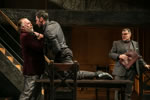 Richard III, Shakespeare Theatre of New Jersey, Madison, New Jersey. Shakespeare's play became a modern gangland tale in Paul Mullins' staging, featuring stunning production values and film noir edginess in the performances. Derek Wilson's Richard was equal parts charm and danger, a master at playing an audience (fellow characters on stage and the theater patrons) as he entwined his victims in his psychological web. Some cuts and telescoping mar the production, but combining First Murderer, Lovell, and Catsby into one man (Sheffield Chastain) results in a character nearly as fascinating as Richard himself. [Not yet reviewed.]
Richard III, Shakespeare Theatre of New Jersey, Madison, New Jersey. Shakespeare's play became a modern gangland tale in Paul Mullins' staging, featuring stunning production values and film noir edginess in the performances. Derek Wilson's Richard was equal parts charm and danger, a master at playing an audience (fellow characters on stage and the theater patrons) as he entwined his victims in his psychological web. Some cuts and telescoping mar the production, but combining First Murderer, Lovell, and Catsby into one man (Sheffield Chastain) results in a character nearly as fascinating as Richard himself. [Not yet reviewed.]
 Two Gentlemen of Verona, American Shakespeare Center, Blackfriars Playhouse, Staunton, Virginia. OK, I'm sold. This is a good play. Heck, this is a good Shakespeare play. Jemma Alix Levy's respectful, text-centric production reveals many psychological truths in this early Shakespeare work while an ensemble as talented as I've seen anywhere not only present well defined characters but the dynamics of key pairings, i.e., Valentine (Ross Neal) and Proteus (Josh Clark), Julia (Sara J. Griffin) and Lucetta (Constance Swain). Levy played up the comedy gurgling in every scene, but played the final sequence seriously. And it works. [Not yet reviewed.]
Two Gentlemen of Verona, American Shakespeare Center, Blackfriars Playhouse, Staunton, Virginia. OK, I'm sold. This is a good play. Heck, this is a good Shakespeare play. Jemma Alix Levy's respectful, text-centric production reveals many psychological truths in this early Shakespeare work while an ensemble as talented as I've seen anywhere not only present well defined characters but the dynamics of key pairings, i.e., Valentine (Ross Neal) and Proteus (Josh Clark), Julia (Sara J. Griffin) and Lucetta (Constance Swain). Levy played up the comedy gurgling in every scene, but played the final sequence seriously. And it works. [Not yet reviewed.]
Honorable Mentions:
Top 10 Non-Shakespearean Theatrical Moments of 2016
- Sense & Sensibility, Folger Theatre, Washington, D.C. This production by the New York-based theater company Bedlam and helmed by
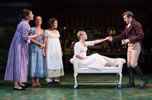 its artistic director, Eric Tucker, has been wowing Gotham audiences for two years. Now it has wowed us with its restaging at the Folger Theater. Armed with Kate Hamill's slick-moving but still emotionally rich adaptation of Jane Austen's novel, Tucker does some tour de force directing with a remarkably talented ensemble of 10 actors playing multiple characters, furniture, beasts, and weather, too. With the set and most of the props on wheels, the perfectly timed choreography of set and actors kept the action moving nonstop, and the use of Gossips around the theater puts us inside that action. Every performance was superb, in terms of both character portrayals and split-second physical agility, but special kudos go to Maggie McDowell as Elinor Dashwood, bottling up a fireworks of emotions in the most prim and proper of bearings, and Lisa Birnbaum who plays three roles. One was the steady Mrs. Dashwood. The other two roles required her to pull off this year's most indelible theater moment when she and fellow actress Kathryn Tkel transitioned from one character to a completely different personification in the time it took for them in their chairs to be sent spinning across the stage, a transition that happened a total of four times in one scene. All in all, this production left us in awe, and filled us with the spirit of Austen, too.
its artistic director, Eric Tucker, has been wowing Gotham audiences for two years. Now it has wowed us with its restaging at the Folger Theater. Armed with Kate Hamill's slick-moving but still emotionally rich adaptation of Jane Austen's novel, Tucker does some tour de force directing with a remarkably talented ensemble of 10 actors playing multiple characters, furniture, beasts, and weather, too. With the set and most of the props on wheels, the perfectly timed choreography of set and actors kept the action moving nonstop, and the use of Gossips around the theater puts us inside that action. Every performance was superb, in terms of both character portrayals and split-second physical agility, but special kudos go to Maggie McDowell as Elinor Dashwood, bottling up a fireworks of emotions in the most prim and proper of bearings, and Lisa Birnbaum who plays three roles. One was the steady Mrs. Dashwood. The other two roles required her to pull off this year's most indelible theater moment when she and fellow actress Kathryn Tkel transitioned from one character to a completely different personification in the time it took for them in their chairs to be sent spinning across the stage, a transition that happened a total of four times in one scene. All in all, this production left us in awe, and filled us with the spirit of Austen, too.
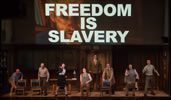 1984, Headlong/Nottingham Playhouse/Almeida Theatre, Shakespeare Theatre Company, Washington, D.C. "Where do you think you are, Winston?" intones a voice that was asking us the same thing. In Robert Icke and Duncan Macmillan's stage adaptation of George Orwell's novel, we were in 1984, but also in 2050 and maybe even 1948. Or, really, we were in 2016. Icke and Macmillan also directed this brilliant rendering of Big Brother's palpably pervasive paranoia and the mind-numbing impact of thought control through changing historical record, unpeopling individuals, and always shifting truth and facts. Leading a strong cast was Matthew Spencer as Winston, physically presenting the protagonist's psychological fracturing and enduring all manner of abuse and torture in Room 101. Presented in the larger context of these political times, this production was profoundly moving and genuinely frightening.
1984, Headlong/Nottingham Playhouse/Almeida Theatre, Shakespeare Theatre Company, Washington, D.C. "Where do you think you are, Winston?" intones a voice that was asking us the same thing. In Robert Icke and Duncan Macmillan's stage adaptation of George Orwell's novel, we were in 1984, but also in 2050 and maybe even 1948. Or, really, we were in 2016. Icke and Macmillan also directed this brilliant rendering of Big Brother's palpably pervasive paranoia and the mind-numbing impact of thought control through changing historical record, unpeopling individuals, and always shifting truth and facts. Leading a strong cast was Matthew Spencer as Winston, physically presenting the protagonist's psychological fracturing and enduring all manner of abuse and torture in Room 101. Presented in the larger context of these political times, this production was profoundly moving and genuinely frightening.
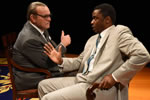 All the Way, Arena Stage, Washington, D.C. Robert Schenkkan's play about President Lyndon Johnson's first year in office was Number One on our 2012 Shakespeareances Honorable Mention list when we first saw it at the Oregon Shakespeare Festival (OSF). However, the 2014 Broadway staging with Bryan Cranston playing LBJ came in at Number 20 (out of 23). Arena Stage restored the play's power by casting Jack Willis to reprise his portrayal of LBJ he originated at OSF and assembling a solid cast of actors (all new to the play) who turned historical icons into right-there humans, especially Bowman Wright as Martin Luther King Jr. Director Kyle Donnelly used theater-in-the-round staging to highlight the nuances of character relationships, revealing more facets to one of our all-time favorite plays.
All the Way, Arena Stage, Washington, D.C. Robert Schenkkan's play about President Lyndon Johnson's first year in office was Number One on our 2012 Shakespeareances Honorable Mention list when we first saw it at the Oregon Shakespeare Festival (OSF). However, the 2014 Broadway staging with Bryan Cranston playing LBJ came in at Number 20 (out of 23). Arena Stage restored the play's power by casting Jack Willis to reprise his portrayal of LBJ he originated at OSF and assembling a solid cast of actors (all new to the play) who turned historical icons into right-there humans, especially Bowman Wright as Martin Luther King Jr. Director Kyle Donnelly used theater-in-the-round staging to highlight the nuances of character relationships, revealing more facets to one of our all-time favorite plays.
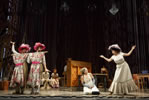 Into the Woods, Fiasco Theater, John F. Kennedy Memorial Center for the Performing Arts, Washington, D.C. After its success with Shakespeare plays, the New York-based Fiasco Theater company, whose Cymbeline topped the 2014 Shakespeareances list, applied its small-cast, radical staging concepts to a Stephen Sondheim musical with equally positive results: you leave the theater feeling special. Though it seems you are watching a rehearsal, Co-directors Noah Brody and Ben Steinfeld have carefully crafted the staging and casting to explore subtle complexities of the piece. Nevertheless, it's the blurring of the fourth wall that elevates the experience from merely watching a show to being integrated into it. [Not yet reviewed.]
Into the Woods, Fiasco Theater, John F. Kennedy Memorial Center for the Performing Arts, Washington, D.C. After its success with Shakespeare plays, the New York-based Fiasco Theater company, whose Cymbeline topped the 2014 Shakespeareances list, applied its small-cast, radical staging concepts to a Stephen Sondheim musical with equally positive results: you leave the theater feeling special. Though it seems you are watching a rehearsal, Co-directors Noah Brody and Ben Steinfeld have carefully crafted the staging and casting to explore subtle complexities of the piece. Nevertheless, it's the blurring of the fourth wall that elevates the experience from merely watching a show to being integrated into it. [Not yet reviewed.]
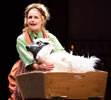 Second Shepherd's Play, Folger Consort, Washington, D.C. I counted on this, my first-ever medieval mystery play, being an educational experience. What was most enlightening was how charmingly entertaining was this tickle-fest about shepherds making two visits to nearby cradles, one bearing a stolen sheep, the other bearing the Christ Child. An ensemble of top-tier actors, a bit of puppetry, and four members of the Folger Consort playing and singing ancient carols on ancient instruments all combined to not only make for an enjoyable night of theater but also a spiritually uplifting celebration of the season.
Second Shepherd's Play, Folger Consort, Washington, D.C. I counted on this, my first-ever medieval mystery play, being an educational experience. What was most enlightening was how charmingly entertaining was this tickle-fest about shepherds making two visits to nearby cradles, one bearing a stolen sheep, the other bearing the Christ Child. An ensemble of top-tier actors, a bit of puppetry, and four members of the Folger Consort playing and singing ancient carols on ancient instruments all combined to not only make for an enjoyable night of theater but also a spiritually uplifting celebration of the season.
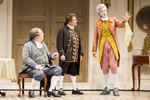 The Critic/The Real Inspector Hound, Shakespeare Theatre Company and Guthrie Theater, Washington, D.C. Comprising a twin bill, these two plays, written almost 200 years apart, use the same device of two critics watching a play to poke fun at critics. No complaints from this critic as Director Michael Kahn and a courageous cast made bad plays within the plays such great fun. The Critic was pure slapstick, from an English Channel that stripped costumes off the actors to the prompter, filling in for two cast members, swordfighting with himself. The Real Inspector Hound featured Tom Stoppard's stinging wit and shifting reality, turning more poignant with each surreal turn. Five-star entertainment!
The Critic/The Real Inspector Hound, Shakespeare Theatre Company and Guthrie Theater, Washington, D.C. Comprising a twin bill, these two plays, written almost 200 years apart, use the same device of two critics watching a play to poke fun at critics. No complaints from this critic as Director Michael Kahn and a courageous cast made bad plays within the plays such great fun. The Critic was pure slapstick, from an English Channel that stripped costumes off the actors to the prompter, filling in for two cast members, swordfighting with himself. The Real Inspector Hound featured Tom Stoppard's stinging wit and shifting reality, turning more poignant with each surreal turn. Five-star entertainment!
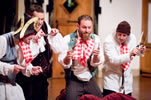 The Sea Voyage, American Shakespeare Center, Blackfriars Playhouse, Staunton, Virginia. This piece of tripe from John Fletcher and Phillip Massinger showcased what the Actors' Renaissance Season troupe could accomplish with their collective talents and ensemble sensibilities. From the four stooges preparing to dine on the ingénue to the "moldy cheese" complaint from Patrick Midgley's Tibalt Dupont, from René Thornton Jr.'s and Chris Johnston's truthful playing of lovely Amazon women to Chad Bradford's heroic reading of the truehearted Pirate Albert, this company established itself as one of the best I've seen on the Blackfriars Playhouse stage and beyond.
The Sea Voyage, American Shakespeare Center, Blackfriars Playhouse, Staunton, Virginia. This piece of tripe from John Fletcher and Phillip Massinger showcased what the Actors' Renaissance Season troupe could accomplish with their collective talents and ensemble sensibilities. From the four stooges preparing to dine on the ingénue to the "moldy cheese" complaint from Patrick Midgley's Tibalt Dupont, from René Thornton Jr.'s and Chris Johnston's truthful playing of lovely Amazon women to Chad Bradford's heroic reading of the truehearted Pirate Albert, this company established itself as one of the best I've seen on the Blackfriars Playhouse stage and beyond.
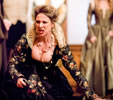 Women Beware Women, American Shakespeare Center, Blackfriars Playhouse, Staunton, Virginia. Is it a comedy or a tragedy? It was both in the expert hands of this Actors' Renaissance Season company. Thomas Middleton's play with its simple morality and multiple deaths by multiple means could come off as dated or a farce or just a mess, but here it came off as disturbingly relevant, a cautionary tale of the choices one makes, and a scintillating thriller. The centerpiece character was this production's centerpiece performance, Ginna Hoben as Livia, whose wail of grief, frustration, and anger still echoes in my head.
Women Beware Women, American Shakespeare Center, Blackfriars Playhouse, Staunton, Virginia. Is it a comedy or a tragedy? It was both in the expert hands of this Actors' Renaissance Season company. Thomas Middleton's play with its simple morality and multiple deaths by multiple means could come off as dated or a farce or just a mess, but here it came off as disturbingly relevant, a cautionary tale of the choices one makes, and a scintillating thriller. The centerpiece character was this production's centerpiece performance, Ginna Hoben as Livia, whose wail of grief, frustration, and anger still echoes in my head.
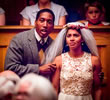 Our Town, American Shakespeare Center, Blackfriars Playhouse, Staunton, Virginia. The American Shakespeare Center's touring troupe has the musical verve of an unplugged Springsteen or Stones show (no electronics in the Blackfriars Playhouse). More important, all the music is thematically appropriate, reinforcing its resonance. Director Jim Warren melded the meta-theater elements of Thornton Wilder's play with the environment and playing style of Shakespeare's own indoor theater, and a tight and talented ensemble led by the subversively understated performance of Andrew Goldwasser as the Stage Manager, emphasized how living is as important—if not more important—as life itself. Cue the sniffles. [Not yet reviewed.]
Our Town, American Shakespeare Center, Blackfriars Playhouse, Staunton, Virginia. The American Shakespeare Center's touring troupe has the musical verve of an unplugged Springsteen or Stones show (no electronics in the Blackfriars Playhouse). More important, all the music is thematically appropriate, reinforcing its resonance. Director Jim Warren melded the meta-theater elements of Thornton Wilder's play with the environment and playing style of Shakespeare's own indoor theater, and a tight and talented ensemble led by the subversively understated performance of Andrew Goldwasser as the Stage Manager, emphasized how living is as important—if not more important—as life itself. Cue the sniffles. [Not yet reviewed.]
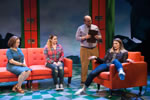 Freaky Friday, Signature, Arlington, Virginia. Sure, it's Disney with the easy-on-the-brain moral message. Sure, it's another movie made over as a musical. Nevertheless, Freaky Friday sure was fun. Heidi Blickenstaff as the mother was a true delight, acting, singing, and merging both talents into a consistently captivating performance. The plot is not only trite it's a bit far-fetched (way beyond the central plot point of mother and daughter magically switching bodies). But the book by Bridget Carpenter, catchy tunes by Tom Kitt, and clever lyrics by Brian Yorkey allow some indelible performances, particularly that of Jason Gotay as Adam. [Not yet reviewed.]
Freaky Friday, Signature, Arlington, Virginia. Sure, it's Disney with the easy-on-the-brain moral message. Sure, it's another movie made over as a musical. Nevertheless, Freaky Friday sure was fun. Heidi Blickenstaff as the mother was a true delight, acting, singing, and merging both talents into a consistently captivating performance. The plot is not only trite it's a bit far-fetched (way beyond the central plot point of mother and daughter magically switching bodies). But the book by Bridget Carpenter, catchy tunes by Tom Kitt, and clever lyrics by Brian Yorkey allow some indelible performances, particularly that of Jason Gotay as Adam. [Not yet reviewed.]
The rest of the Shakespeareances …
-
Coriolanus, Red Bull Theater, New York, New York. Having played Coriolanus three years ago, Patrick Page took on the character of Menenius Agrippa in this Michael Sexton–helmed, modern-dress, intimate-theater presentation. Despite his vocal powers and physical virility, it's Page's intellect that makes his characters so indelible, and his playing the patrician senator as a Dixie politician turns what could have been trite trappings into an incisive character study of the man who serves as Coriolanus's mentor and father figure. In a well played but sometimes over-busy production, it was Page's Menenius that gripped us. [Not yet reviewed.]
- Romeo and Juliet, Kentucky Shakespeare Festival, Louisville, Kentucky. This production, well acted and staged, got its poignancy by the fact that we saw it in Louisville a month after Muhammad Ali's funeral and on the weekend five Dallas, Texas, police officers were killed by sniper fire during a Black Lives Matter rally. Director Matt Wallace, who had previously staged the play in his Shakespeare Behind Bars program, dove into Shakespeare's verse to find the impact of endemic hatred and violence on individual and communal psychosis, especially for a society in transition, such as 1303 Verona and 2016 America.
- Richard II, Shakespeare's Globe “Globe on Screen,” London, England. Someday—in my lifetime, I hope—Richard II will surpass Shakespeare's other Richard history in popularity. II is a more masterfully constructed play and features some of Shakespeare's most dramatic verses and character dynamics. But it will take productions like this Simon Godwin–helmed staging, with its unexpected verve and physicality, to convince people to give Richard II a chance. Godwin mines the script for both action sequences and easy comedy so that this Richard II leans more toward a Showtime series than iambic pentameter opera. [Not yet reviewed.]
- The Taming of the Shrew, Public's Free Shakespeare in the Park, New York, New York. Janet McTeer re-created herself as a gangly, crude, and unfalteringly cocky Petruchio in this all-female production directed by Phyllida Lloyd, who turned Shakespeare's romping comedy into a feminist manifesto while maintaining the fun of the original. The greater achievement of this production, however, was pegging it to the undercurrent of sexism running through the U.S. presidential campaign, using a beauty pageant with Donald Trump as emcee for a framing device (a choice drawn from one of Petruchio's lines in the play).
- As You Like It, Children's Shakespeare Theatre, Sparkill, New York. Let's be clear here: The fact that these are kids ages 8–14 has nothing whatsoever to do with this rating. It all comes down to how much, respective to other productions we've seen this year, would I want to see it again. Absolutely would I want to relish again Kate Gadd's brilliantly conceived Phoebe and Cole Massaro's hilarious Corin, to appreciate the endearing Orlando of Noah King and impish Rosalind of Anna Puris, and to indulge in the Flower Power setting and Beatles soundtrack. Kids? This was good Shakespeare.
- Richard III, Almeida Theatre Live, Folger Theatre, Washington, D.C. The acting power in this production—Ralph Fiennes as Richard and Vanessa Redgrave as Margaret—foretold an exhilarating staging of Shakespeare's history play. Instead, Director Ruport Goold gave us a history-in-the-making play, turning Richard—with the discovering of his grave in 2013 as the play's framework—into a cautionary tale for personality cult politics and nationalistic fervor taking over a nation's government. It's a deeply troubling piece of work, well crafted, but undermined by Goold's taking one liberty too many with Shakespeare's text.
- Romeo and Juliet, American Ballet Theatre, Wolf Trap, Vienna, Virginia. Kenneth MacMillan's choreography of Romeo and Juliet departs from Shakespeare's plot and avoids the play's themes. However, in concentrating on Juliet's coming of age, MacMillan created a character that can be thrilling to watch when danced by prima ballerinas. We saw a current best in Misty Copeland, whose graceful athleticism and charisma melded beautifully with Joseph Gorak's precisely exquisite Romeo for breathtaking moments. This was an add-on performance to see Copeland. The night before we saw the feather-like Hee Seo as Juliet, and she, too, left us breathless. Brava!
- The Winter's Tale, Baltimore Shakespeare Factory, Baltimore, Maryland. The calling card for this production was its use of Original Pronunciation; however, first-time Director James Keegan brought new insights by presenting Time as a gardener; casting as Time the actress playing Paulina, Marianne Gazzola Angelella; and using a Build-a-Bear visual for the famous stage direction. Plus, under Keegan's direction, Chris Cotterman discovered the hurt in Leontes that prompts him to go all-Iago on himself, a reading that was among the most truthful I've seen.
- Falstaff, Shakespeare Opera Theatre, Hylton Performing Arts Center, Manassas, Virginia. My first Shakespeare opera accomplished the Shakespeare Opera Theatre's two stated missions: to use opera adaptations to explore Shakespeare's works, and to turn Shakespeare lovers into opera lovers. Under the direction and baton of Lori Lind, a seven-piece ensemble to the side of the stage achieved sufficient orchestral grandeur, Kevin Rockower made an appealing Falstaff, especially in his aria to sack, and CJ David and Jennifer Sin blended gorgeously in the duets of Fenton and Nannetta, attaining the high benchmark Verdi sets for them with his score.
- King Lear, American Shakespeare Center, Blackfriars Playhouse, Staunton, Virginia. It's fascinating to watch this play presented in the manner that Shakespeare himself most likely conceived it. Director Jenny Bennett uses the text and its context in Shakespeare's canon to get into the mind of the playwright as she explores the staging conditions of his time with her clever use of the Blackfriars Playhouse conditions (the storm and battle sound effects are especially exhilarating). The problem is, Shakespeare in 1606 didn't seem to take this tragedy as seriously as we do in 2016, and it plays too funny for my taste.
- District Merchants, Folger Theatre, Washington, D.C. Aaron Posner always crosses the line into adaptation when he directs a Shakespeare play, so I looked forward to his outright rewrite of The Merchant of Venice. Re-setting Shakespeare's plot in Reconstruction-Era Washington and reimagining some of the characters, including Antonio, as African-Americans focused on key themes of Shakespeare's original and illuminate the troubling, enduring nature of racism in our own time and in our own selves. Posner over-uses direct-address soliloquies, causing a powerful production to peter out, but at its climax Shylock stabbed us with something more damning than his knife's blade.
- Henry VI, Part One, Taffety Punk, Folger Theatre, Washington, D.C. Though mounted in one day, Taffety Punk's Bootleg Shakespeare productions are no slouches. Last year's The Two Gentlemen of Verona even topped this list. This year's version was no slouch, either, but did stoop under its own weight. With a cast of 32 playing 75 named roles plus six "et als.," it lacked the tightness of past Bootlegs. Nevertheless, the process allowed Shakespeare's intent to emerge, and we got memorable performances, including one of the et als., a note-scribbling sycophant in Gloucester's entourage (Tonya Beckman, who also played Margaret).
- William Shakespeare's Long-Lost First Play (abridged), Reduced Shakespeare Company, Folger Theatre, Washington, D.C. Epic silliness is a good thing, and the Reduced Shakespeare Company can bring it better than anyone. Thanks to its members' thorough knowledge of the canon—lines, characters, allegorical arcs, and poetic nuances—RSc co-writers Reed Martin and Austin Tichenor (joined in this production by the smart Teddy Spencer) gave great depth to their knock-off jokes, vaudevillian humor, and wonderfully awful puns. As confection goes, with so many layers in this production, it was pretty fulfilling.
- Romeo and Juliet, Shakespeare Theatre Company, Washington, D.C. Director Alan Paul, a former Shakespeare Theatre Company assistant director, brought his expertise in staging musicals and operas to this his first from-scratch production of a Shakespeare play, and it shows, at first. The line readings from the cast were rhythmically and succinctly given, showing off various tonal levels while carrying an easy casualness. However, Paul focused his attention in the play's latter half on what he saw as dysfunction in the Capulet family, and that and other character miscalculations and trims sent this production racing off the rails by the end.
- The Two Gentlemen of Verona, Shakespeare Festival, Louisville, Kentucky. This presentation was only half as good as it could have been; that's because a thunderstorm forced cancellation of the second half. The 1919 English country manor timeframe aided in the narrative (especially in Megan Massie's portrayal of Lucetta), but that setting primarily was an excuse to end each scene in a song-and-dance-of-the-era number. Jon Patrick O'Brien played Proteus as completely self-indulgent in his approach to romance, an ego that easily justified betraying both his best friend and Julia. Too bad the rain kept us from seeing how it all would end.
- Love's Labour's Lost, 4615 Theatre Company, Washington, D.C. The Millennial spirit of a company founded by and comprising young actors at the dawn of their careers was part and parcel of this staging. The good was how they bring out the youthful exuberance of the quartet of couples and Berowne's spoiled nature. The bad was, well, a cast largely without the training and experience to speak Shakespeare's verse effectively. An exception was Alexandra Nicopoulos as the Princess who, because she grasps the verse so well, grasps one of the canon's most complex women so well.
- A Midsummer Night's Dream, Folger Theatre, Washington, D.C. Aaron Posner is a visionary director, and he expresses much affection for Shakespeare. Unfortunately, he never shows much loyalty to Shakespeare's scripts, infusing his productions with his own peculiar idiosyncrasies and fetishes. Things like turning Bottom into a brilliant actor, thus undermining the comedy of the finale, tended to cloud my affections for the insightful elements of this production, like Erin Weaver's athletic Puck playing with the audience and Eric Hissom's funny but virile Oberon (and not so virile Theseus) stage-managing the play's business.
- King Lear, Royal Shakespeare Company, “Live from Stratford-upon-Avon” broadcast, Stratford-upon-Avon, England. I could hardly wait to see the incomparable Antony Sher take on my favorite play. Sadly, the production and Sher's Lear were overly pompous, and I could hardly wait for both to be finished. Sher brings an intellectual reading to his roles, finding character traits overlooked by most other readers, and he sees Lear as a man infatuated with his virility. However, there's no heart in the playing, and with no heart, there's no cause, no cause, for caring at the end (let along crying). [Not yet reviewed.]
- Pericles, Theatre for a New Audience, Brooklyn, New York. Word that Trevor Nunn was going to direct this rarity automatically prompted us to renew our subscription to the Theatre for a New Audience, though this was the only production we could be certain of attending. I couldn't wait to see what creative genius Nunn would apply to this malformed play. Instead, he went inside-out, not only adhering to the play's formal structure for a most elegiac presentation, but embracing George Wilkins as Pericles's chief writer. Overlong and lacking charm, this outing proved more of a snoozer than entertainment.
- Romeo and Juliet, Kenneth Branagh Theatre Company, “Branagh Theatre Live,” London, England. Kenneth Branagh directing a Shakespeare play! Derek Jacobi playing Mercutio! Hotter-than-hell TV stars and Cinderella co-stars Richard Madden and Lily James playing Romeo and Juliet! What's not to like? Just about all of it, as it turns out. Branagh screws with the text, the young stars haven't a clue what they are feeling, and while portraying Mercutio as an old gay uncle is interesting to ponder, it's discomforting to watch. [Not yet reviewed.]
- The Taming of the Shrew, Shakespeare Theatre Company, Washington, D.C. With such a party atmosphere surrounding this production, Director Ed Sylvanus Iskandar's over-serious, psychologically heavy adaptation of the play was jarring. So was his reason for casting only men: he did it out of care for the sensitive psyches of actresses. That attitude made a production that was as funny as a fatal heart attack (though the fatal heart attack inserted into the play got the night's biggest laughs) seriously sexist.
…and the rest of the non-Shakespeareances:
- The Father, Theatre for a New Audience, Brooklyn, New York. Paired in repertoire with A Doll's House, this August Strindberg play turns domestic gender politics into a psychological thriller. With intense performances by John Douglas Thompson as the Captain and Maggie Lacey as his wife, Laura, plus fearless work by Kimber Monroe as their daughter, Bertha, Director Arin Arbus delivered a taut narrative that was gut-wrenching to watch and deeply disturbing in subtext. This was one of those plays (Death of a Salesman was another) that I walked away from shuddering. [Not yet reviewed.]
- A Doll's House, Theatre for a New Audience, Brooklyn, New York. Paired in repertoire with The Father, both directed by Arin Arbus, this is the Thornton Wilder adaptation of Henrik Ibsen's domestic masterpiece. Maggie Lacey delivered an incredibly nuanced performance as Nora Helmer, ridiculously immature in the opening scenes but revealing in the final scene how her true persona has been trapped by social expectations. In Lacey's performance we saw Nora slowly but concertedly dig her way out of her psychological prison cell. [Not yet reviewed.]
- Arms and the Man, American Shakespeare Center, Blackfriars Playhouse, Staunton, Virginia. Not only do I love George Bernard Shaw's work, I've never seen any of his plays done poorly. This one holds true to form, even though it is not one of Shaw's strongest scripts. Andrew Goldwasser found a complexity of dimensions in his portrayal of Captain Bluntschlie, Zoe Speas buried a woman's instincts in her Raina's stubborn naiveté, Josh Innerst revealed several layers in his performance as Sergius, and Chris Bellinger as the bellicose Major Petkoff spoke more volumes in his facial expressions than his loud proclamations. [Not yet reviewed.]
- Bloody Bloody Andrew Jackson, American Shakespeare Center, Blackfriars Playhouse, Staunton, Virginia. You can question the American Shakespeare Company's decision to stage this rock musical that has nothing to do with Shakespeare, but staging it at the Blackfriars Playhouse with talented actors doing double-duty as the on-stage band (unplugged in the non-electronics asthete of the Blackfriars), is merit enough. Patrick Earl was sexy and strong as the titular Jackson, Stephanie Holladay Earl provided clever choreography, and bandleader Chris Johnston anchored a strong musical corps. Nevertheless, the highlight was a preshow performance of Abba's "Dancing Queen" sung as a plaintive folk ballad by John Harrell and Lauren Ballard.
- The Shoemaker's Holiday, Baltimore Shakespeare Factory, Baltimore, Maryland. I salute Artistic Director Tom Delise's ballsy decision to use Thomas Dekker's cobbled-together city comedy to launch his company's sidetrack into staging works by Shakespeare's contemporaries. In Simon Eyre, Dekker has penned a wannabe Falstaff, but in Firk and Lacy he creates two unique characters, all three spiritedly performed by, respectively, Conrad Deitrick, Ian Blackwell Rogers, and Chris Cotterman. Along with April Forrer's gorgeous costuming and Delise's maturing abilities as a director, this production, a fun romp in and of itself, represents a growth projection for this fledgling company.
- Love for Love, American Shakespeare Center, Blackfriars Playhouse, Staunton, Virginia. After a stellar Renaissance Season from one of the tightest and most talented ensembles we've seen, the troupe's efforts with William Congreve's restoration comedy never quite coalesced. Aside from some individual comic moments, this work from a sharp-witted wordsmith just didn't offer the dramatic muscle conducive to the method and madness of mounting plays during the Ren Season (no director or production team, little rehearsal time). That said, Chris Johnston in the lead role of Valentine further proved his status as a heavyweight player in the American Shakespeare Center pantheon.
- Les Liaisons Dangereuses, Donmar Warehouse, Booth Theatre, New York, New York. Christopher Hampton's play is one of Sarah's favorites. Janet McTeer is one of my favorites. However, this desultory staging helmed by Josie Rourke revealed the play's shallow intellect, and I waited in vain for McTeer as Marquise de Merteuil to wow me (I also waited in vain for Liev Schreiber's Le Vicomte de Valmont to earn the applause that greeted his entrance). Only the mesmerizing performance of Birgitte Hjort Sørensen as Madam de Tourvel made this outing a worthy investment. [Not yet reviewed.]
- The Miser, Faction of Fools, Washington, D.C. A Molière play, especially The Miser, played as commedia dell'arte is an easy fit. Too easy, perhaps. Despite the accomplished commedia skills of the production's five-member cast (with star turns times two by Kathryn Zoerb as the steward Valère and the Zanni-servant La Flèche and Clayton Pelham as the son Cléante and the Scaramuccia-servant Maître Jacques), this show didn't have the sparkling heart and outright audacity we've grown accustomed to in Faction of Fools productions.
- The Maid's Tragedy, Brave Spirits, Sanctuary at Convergence, Alexandria, Virginia. Given the company and the cast, this promised much, especially as director Angela Kay Pirko turned the church serving as the theater into a conceptual metaphor for the play. However, the sanctuary's poor acoustics undermined the better performances, and excessive dramatics worsened the lesser performances. At least the music was great: the medley of "All Creatures of Our God and King" and "Awesome God" for the opening processional and the singing of cast-member Mary Myers were highlights of the year.
- The Secret Garden, Shakespeare Theatre Company, Washington, D.C. If not for hearing Jean Valjean in Michael Xavier's singing in the role of Archibald Craven, this production would have been a total loss for me. Aside from Xavier channeling Colm Wilkinson (no shame in that), I appreciated some of his more poignant lines. Loved ones, he tells young Mary Lennox, are “not gone; they're just dead,” and they become ghosts “if someone is holding onto them.” He also says, “Getting lost is how you learn,” but I can't agree with that sentiment in this case. [Not yet reviewed.]
- The Cherry Orchard, Roundabout Theatre Company, American Airlines Theatre, New York, New York. I am a big fan of Diane Lane. I love her work, and I like looking at her. This might sound sexist, but my single take-away from this production was looking at Lane, especially in her third-act party dress and the modern-dress final scene (don't ask why the cast suddenly advanced a century). Otherwise, this 2 1/2-hour production is best summed up by a line in Anton Chekhov's play: “Life's gone by like I never lived.” Simply looking at my wife in that time would have made far more sense. [Not yet reviewed.]
Comment: e-mail editorial@shakespeareances.com
Start a discussion in the Bardroom







 Find additional Shakespeareances
Find additional Shakespeareances